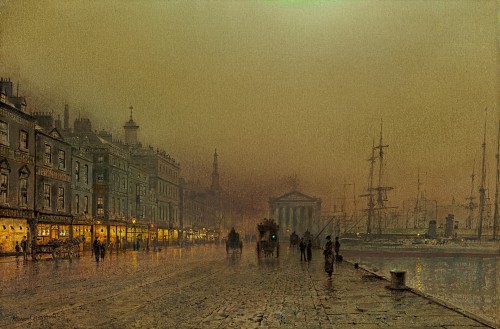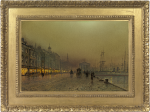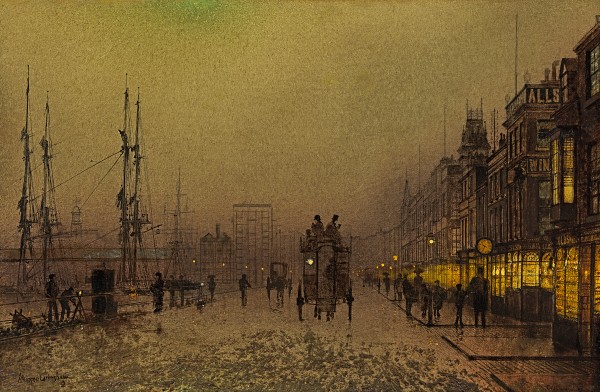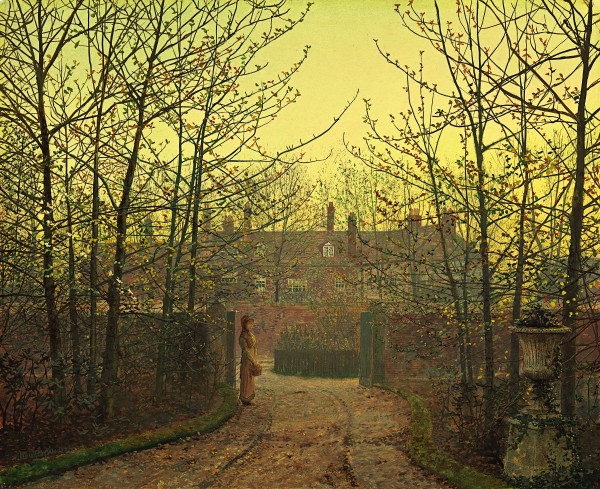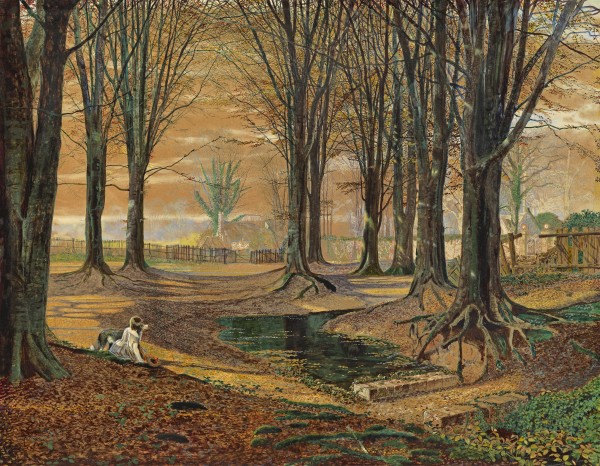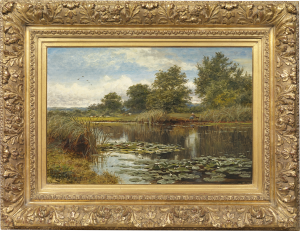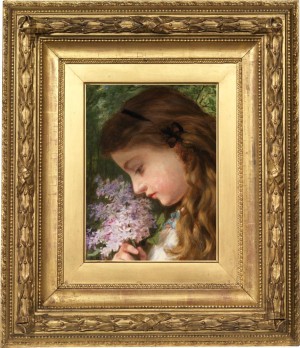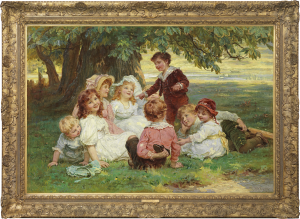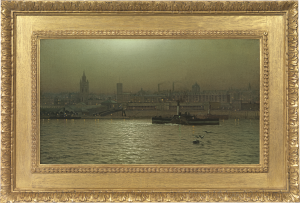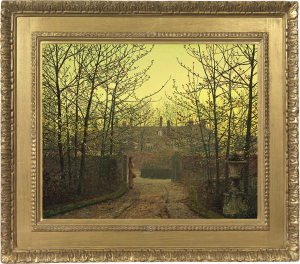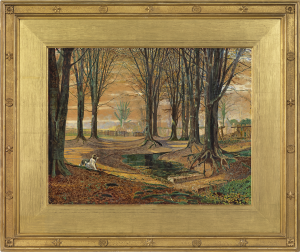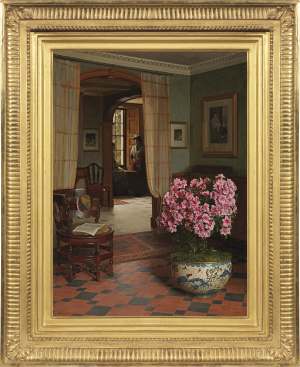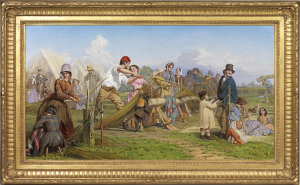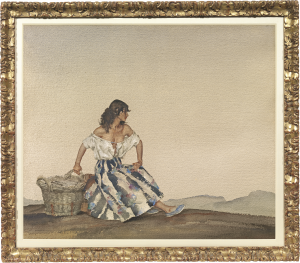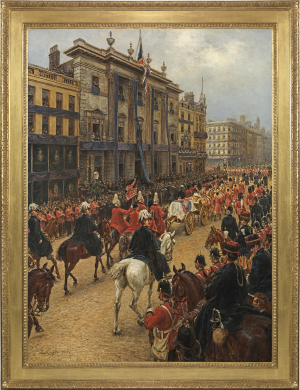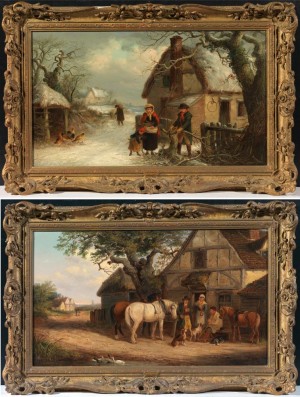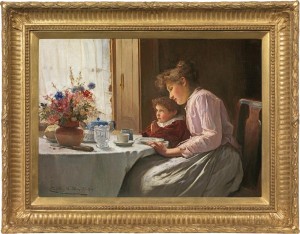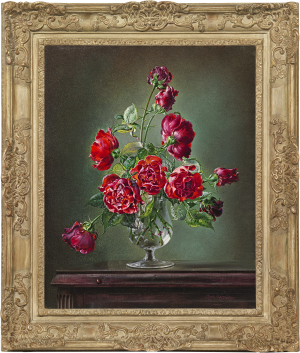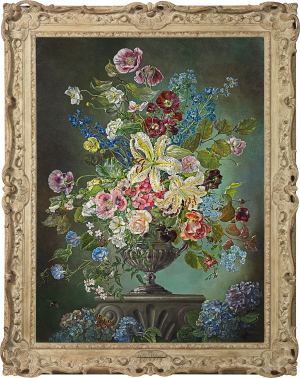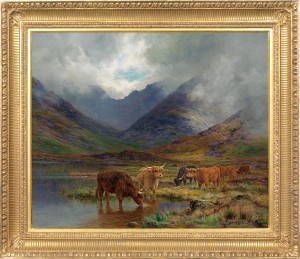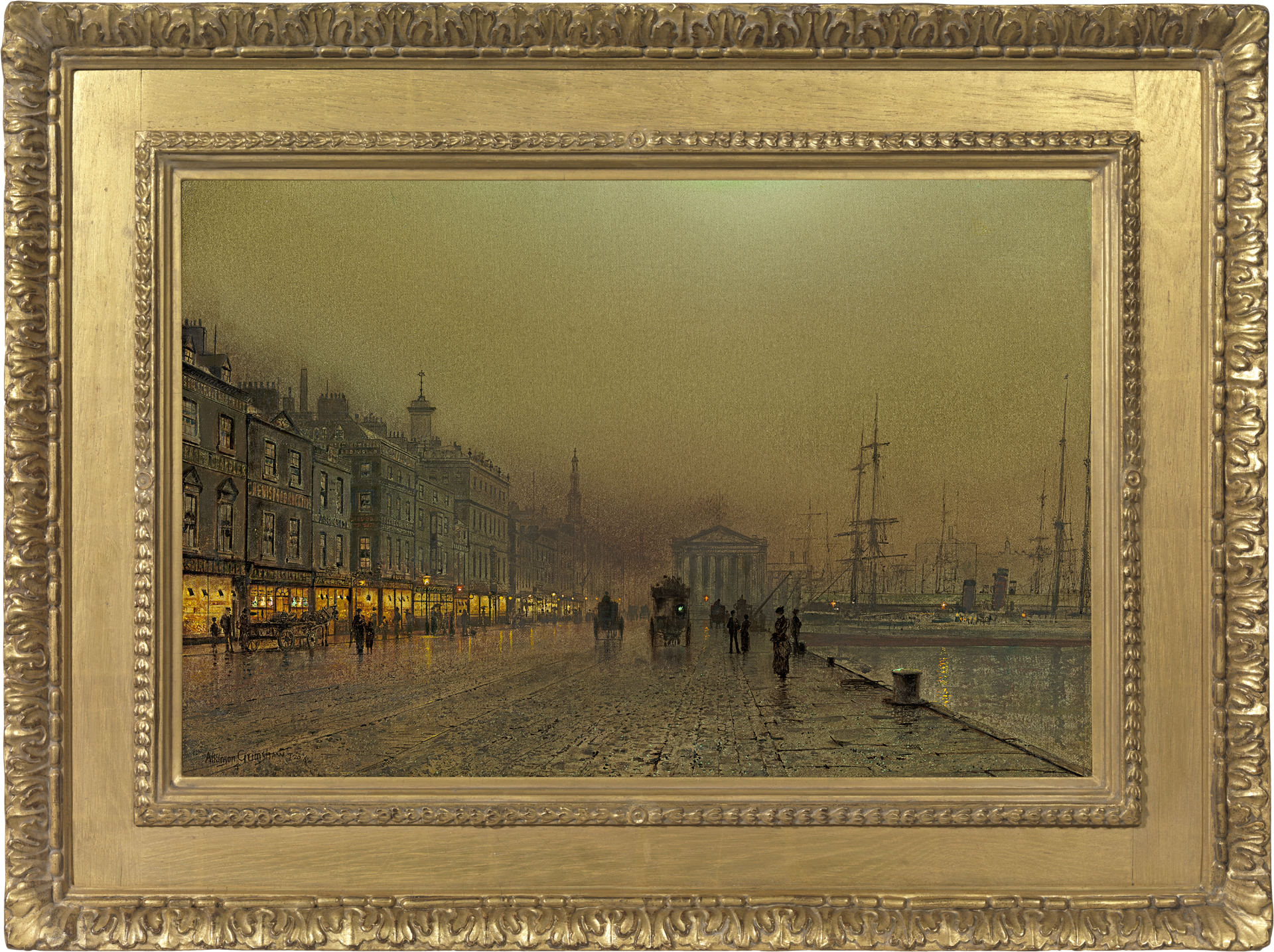John Atkinson Grimshaw
Quay-side, Greenock
Oil on canvas: 12.2 x 18.3 (in) / 31.1 x 46.4 (cm)
Signed, dated and inscribed lower left: Atkinson Grimshaw T 20 / 92; signed, dated and inscribed on the reverse: Quay-side, Greenock / Atkinson Grimshaw / T 20 . 92
This artwork is for sale.
Please contact us on: +44 (0)20 7493 3939.
Email us
JOHN ATKINSON GRIMSHAW
1836 - Leeds - 1893
Ref: CA 169
Quay-side, Greenock
Signed, dated and inscribed lower left: Atkinson Grimshaw T 20 / 92; signed, dated and inscribed on the reverse: Quay-side, Greenock / Atkinson Grimshaw / T 20 . 92
Oil on canvas: 12 ¼ x 18 ¼ in / 31.1 x 46.4 cm
Provenance:
Private collection, UK;
Christie’s London, 20th July 1979, lot 42;
private collection, UK, acquired from the above, then by descent
Richard Green, London
In the 1880s and 90s Atkinson Grimshaw made several views of Greenock, the important port west of Glasgow on the Firth of Clyde, famed for its shipbuilding and other marine industries. As the mist of an autumn evening drifts across the quayside, the light of the gaslit shops glows a welcome orange, mirrored in the rain-slicked cobbles. Pedestrians with umbrellas gaze into bright shop windows on their way home, recalling the heroine of Mrs Gaskell’s, Mary Barton: ‘It is a pretty sight to walk through a street with lighted shops; the gas is so brilliant, the display of goods so much more vivid shown than by day.’
Greenock was world renowned for its shipbuilding, developing quickly from a fishing village into a port in the seventeenth century. Following the Treaty of Union in 1707, Greenock prospered from trade with the Americas, in particular the import of sugar from the Caribbean which was then processed in Greenock’s fourteen refineries. Its first harbour was built by 1710 and the following year saw the establishment of Scott’s, the first major shipbuilders on the Clyde. The port was further developed in the nineteenth century by Scottish civil engineer, John Rennie (who also designed the Southwark and London Bridges, both painted by Grimshaw) and John Gibb. James Watt (1736-1819), born in the Inverclyde area, also undertook improvements to Greenock harbour, though best known for his discovery of steam power, and a dock named after him was built by 1886 to compete with Glasgow for transatlantic shipping traffic as one of the greatest British seaports.
Alexander Robertson, the expert on Atkinson Grimshaw, writes ‘The great ports of Victorian Britain were the life-line of the Empire; the source of wealth and trade. It was therefore not surprising that Grimshaw’s views became so popular…it is the artist’s attention to detail which attracts the eye: the masts and rigging, the reflection of light and colour in the road, the bustle of people and carriages…Grimshaw has transformed the scene and overlaid it with an enveloping sheen of atmosphere and colour bringing out the picturesque and poetic possibilities of the scene’ (A Robertson, John Atkinson Grimshaw, exh. cat., Richard Green, London, 2003, p.10).
The elegant silhouettes of the high masted schooners attest to the region’s main industry, however Grimshaw’s quayside view is primarily artistic license, a poetic representation of the dockside atmosphere he depicted so well. Confirming the artist’s love of maritime scenes, Grimshaw’s dock views may have been influenced by JMW Turner (1775-1851) and JM Whistler (1834-1903). In the early 1880s the artist had a studio in Manresa Road, Chelsea and family history relates a friendship with Whistler, who admired his work and is reputed to have said: ‘I thought I had invented the Nocturne, until I saw Grimmy’s moonlights’ (A Robertson, Atkinson Grimshaw, Phaidon, London, reprinted 2012, p.75).
JOHN ATKINSON GRIMSHAW
1836 - Leeds - 1893
John Atkinson Grimshaw was a Victorian artist who became famous for his sombre views of the dockyards and his nocturnal scenes of urban lanes with leafless trees silhouetted against the moonlight sky. During his later life, he became a close friend of James McNeill Whistler who admired his work and admitted: ‘I considered myself the inventor of nocturnes until I saw Grimmy’s moonlight picture.’
Born in Leeds, the son of an ex-policeman, Grimshaw first took up painting while he was employed as a clerk for the Great Northern Railway. He married his cousin Frances Theodosia Hubbarde in 1858 and by 1861, he had abandoned his job in order to devote all his time to becoming an artist. In his early work, John Atkinson Grimshaw was influenced by John Ruskin’s creed of ‘truth to nature’ and adopted the detailed Pre-Raphaelite technique of the Leeds painter, John William Inchbold. He was also fascinated by the relatively new art of photography and may have used a camera obscura in developing his compositions. Towards 1865, he renounced this painting style. He painted many urban scenes in which moonlight and shadows were the most striking features. The towns and docks that he painted most frequently were Glasgow Liverpool. Leeds, Scarborough, Whitby and London. These works have become his best known though he also painted landscapes, portraits, interior scenes, fairy pictures and neo-classical subjects. Grimshaw painted mostly for private patrons. He only exhibited five works at the Royal Academy between 1874 and 1876.
By 1870, Grimshaw had become successful enough to move to Knostrop Old Hall, a seventeenth century mansion about two miles from the centre of Leeds, which featured in many of his paintings. He rented another home near Scarborough which he called ‘The Castle by the Sea’, towards 1876. Grimshaw suffered a serious financial disaster in 1879 and had to leave his house at Scarborough. He moved to London and rented a studio in Chelsea, leaving his family at Knostrop. He returned to Knostrop, where he died in 1893. Several of his children, Arthur Grimshaw (1868-1913), Louis Grimshaw (1870-1944), Wilfred Grimshaw (1871-1937) and Elaine Grimshaw (1877-1970), became painters.
The work of Grimshaw is represented in the Bradford City Art Gallery, the Shipley Art Gallery, Gateshead, the Gloucester Museum and Art Gallery, the Bankfield Museum, Halifax, the Harrogate Museums and Art Gallery, the Ferens Art Gallery, Kingston-upon-Hull, the Huddersfield Art Gallery, Kirklees Metropolitan Council, the Harris Art Gallery, Preston, the Leeds City Art Gallery, the Walker Art Gallery, Liverpool, the Guildhall Art Gallery and the Tate Gallery, London, the Scarborough Art Gallery, the Wakefield Art Gallery and Museums, the Pannett Gallery, Whitby, the Musée des Beaux-Arts, Brest, France, the Wadsworth Atheneum, Hartford, Connecticut, the Nelson-Atkins Gallery, Kansas City, Missouri, the Minneapolis Institute of Arts, Minneapolis, Minnesota, the Yale Center for British Art, New Haven, Connecticut, the Museum of Art, New Orleans, Louisiana, the Rhode Island School of Design, Providence, Rhode Island in the United States, the Shepparton Art Centre, Welsford, Victoria, Australia and the King George VI Art Gallery, Port Elizabeth, South Africa.

